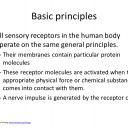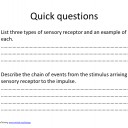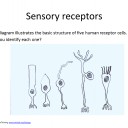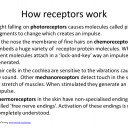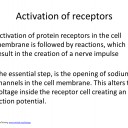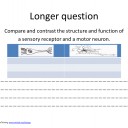Sensory receptors and smell
 In this activity students look first at the way that the sense of smell connects to the brain and how these impulses from the olfactory membrane can provoke strong emotional memories. In a second activity students collect information about the four types of sensory receptors and arrange in a diagram using SOLO hexagons and their own personal annotations.
In this activity students look first at the way that the sense of smell connects to the brain and how these impulses from the olfactory membrane can provoke strong emotional memories. In a second activity students collect information about the four types of sensory receptors and arrange in a diagram using SOLO hexagons and their own personal annotations.
Lesson Description
Guiding Question
Why is smell more important than you think?
|
Look at the diagram (click to enlarge) |
Watch the video from 1min56 up to 5 mins |
How do sense receptors work? ..................................................................
What is the role of our sense of smell? .........................................................
This is a test link for just the section of the video needed: https://youtu.be/ns_3My8xoJg?start=116&end=270
Activity 1 - How do we smell?
Watch the short talks about our sense of smell and answer the questions on the worksheet below
Watch the short video by Richard Axel (Winner of the Nobel Prize for discoveries of "odorant receptors and the organization of the olfactory system") called "Olfactury functions of receptors and the brain." Then answer the following seven questions.
Start at 4m33 and stop at about 11 minutes
Questions
1) What is the sensory epithelium of the nose made of?


Which of the following is the best summary of the structure and function of the sensory epithelium in the nose?
(There could be more than one correct answer)
How many different kinds of receptor molecules are made by one kind of receptor molecule?
6) Drag the words below into the spaces in the text to create a summary of key IB Biology points to remember from this short talk.
chemicals in the air receptors dendrites bind brain fMRIdetect change in the environment.
Olfactory receptors detect .
They are neurones with receptor molecules on their .
Chemoreceptor molecules to chemicals in the air
Impulses generated in the receptors are carried to the .
The brain interprets these impulses.
We can study this neural activity using and other methods.
The eye and ear work in a similar way using receptors.
(The complete video is available at on fora.tv if you want to watch more)
Review question, " Why is smell more important than you think?"
This video partly answers the question, ![]() Evolution of the brain and olfactory lobe (2 minutes)
Evolution of the brain and olfactory lobe (2 minutes)
Activity 2 - Types of receptors
There are four types of sensory receptors:
- Chemoreceptors - like those of the smell in the olfactory membrane
- Photoreceptors - like the rods and cones in the retina of the eye
- Mechanoreceptors - sensitive to movement like the sensory hairs in the cochlea of the ear
- Thermoreceptors - sensitive to temperature in the skin for example.
Arrange the ![]() Sensory receptors SOLO hexagons into a diagram which groups the receptors in such a way that we can see what structural details they have in common, and what are the differences.
Sensory receptors SOLO hexagons into a diagram which groups the receptors in such a way that we can see what structural details they have in common, and what are the differences.
Activity 3 - Cochlear implants.
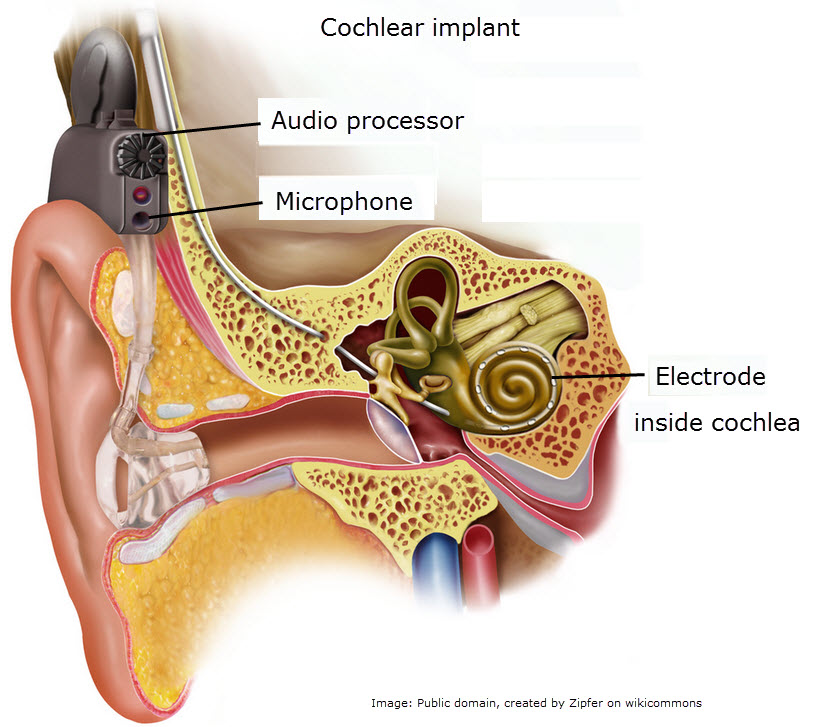 What are they?
What are they?
A cochlear implant (CI) is a surgically implanted electronic device that provides a sense of sound to a person who is profoundly deaf or severely hard of hearing.
Cochlear implants are most useful in helping to provide hearing in patients who are deaf because of damage to sensory hair cells in their cochleas.
Cochlear implants replace the input of those lost or damaged hair cells.
Implants can augment hearing sufficiently to improve understanding of speech and environmental sounds, although the quality of sound is different from natural hearing
Questions
- Which parts of the cochlear implant replace the different functions of the 'hair cells' of the cochlea?
....................................................................................................
....................................................................................................
.................................................................................................... - Explain why the quality of sound is different.
....................................................................................................
....................................................................................................
....................................................................................................
Click the eye icon to display some suggested model answers.
Model answers
- Which parts of the cochlear implant replace the different functions of the 'hair cells' of the cochlea?
The vibrations of sound are picked up by the microphone as the vibrations would be sensed by the hairs on the hair cells.
The impulses are produced by the cochlear electrode.
- Explain why the quality of sound is different.
The position of hair cells in the cochlear correspond to different frequencies of sound, but the arrangement is complex and it is probably not perfectly replicated by the cochlear implant's electrode.
Teachers' notes
This activity is intended as an introduction to the sensory receptors which are important in both sight and hearing. It could be covered quickly, or set as a homework task before a lesson. It helps students understanding of the later elements of this topic if they have a clear idea of how a receptor cell functions and some of the different forms these cells can take.
Activity 1 is a video and questions introduction.
Activity 2 could be a teacher exposition using the gallery of slides, and then students arrange and annotate the hexagons to record the information for themselves. The information on these hexagons is basic and students will probably add their own notes or annotations.
Activity 3 covers the application of this knowledge in medicine, and in particular the NoS point in the guide, "the discovery that electrical stimulation in the auditory system can create a perception of sound resulted in the development of electrical hearing aids and ultimately cochlear implants. (1.2)"
As always there is a lot more that students could know about this topic. This last point is quite interesting and relates to TOK sense perception being imperfect, and also explains optical illusions and magic.
Interesting point about receptors (not in the IB guide)
The sensitivity of a sensory receptor usually depends on how much it has recently been stimulated. Hence, if a receptor (say a nerve fibre in the skin) is exposed to a constant stimulus (such as pressure on the skin) the rate of nerve impulses quickly falls to a much lower level, or even ceases altogether. This phenomenon, called adaptation, leads receptors to be more sensitive to changing than to steady stimulation. Hence they usually measure the stimulus as a percentage of its deviation from the background signal, rather than signalling its absolute intensity. This means that our sensory receptors are sensitive to small changes in signal strength but tune out constant signals. Everyone is familiar with this effect: it is the reason you cease to notice a constant background noise, quickly desensitize to strong smells, and are gradually able to see in a darkened room after leaving one that is brightly lit. It is one example of the way in which our sensory systems ‘economize’ in their use of nerve impulses.
Frances M. Ashcroft, and Colin Blakemore
COLIN BLAKEMORE and SHELIA JENNETT. "taste and smell." The Oxford Companion to the Body. 2001. Encyclopedia.com. 28 Aug. 2016 <http://www.encyclopedia.com>.

 IB Docs (2) Team
IB Docs (2) Team




